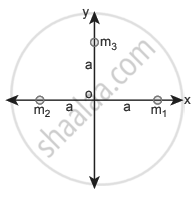Advertisements
Advertisements
प्रश्न
Earth revolves around the Sun at 30 km s−1. Calculate the kinetic energy of the Earth. In the previous example, you calculated the potential energy of the Earth. What is the total energy of the Earth in that case? Is the total energy positive? Give reasons.
उत्तर
Given: V = 30 km s−1
Potential energy = − 49.84 × 1032 J
Mass of earth = 5.9 × 1024
Formula:
Kinetic energy (K.E.) = `1/2"MV"^2`
= `1/2 xx 5.9 xx 10^24 xx 30 xx 30 xx 10^32`
= `1/2 xx 5.9 xx 3 xx 3 xx 10^32`
K.E. = 26.55 × 1032 J
∴ T.E. = K.E. – P.E.
T.E. = 26.55 × 1032 – 49.84 × 1032
T.E. = – 23.29 × 1032 J
Total energy is negative. It implies Earth is bounded with Sun.
APPEARS IN
संबंधित प्रश्न
The gravitational potential energy of the Moon with respect to Earth is ____________.
The work done by the Sun’s gravitational force on the Earth is __________.
If the mass and radius of the Earth are both doubled, then the acceleration due to gravity g'
Define the gravitational field.
What is meant by the superposition of the gravitational field?
Is potential energy the property of a single object? Justify.
Define gravitational potential.
Prove that at points near the surface of the Earth, the gravitational potential energy of the object is U = mgh.
If the ratio of the orbital distance of two planets `"d"_1/"d"_2` = 2, what is the ratio of gravitational field experienced by these two planets?
Calculate the gravitational field at point O due to three masses m1, m2 and m3 whose positions are given by the following figure. If the masses m1 and m2 are equal what is the change in a gravitational field at the point O?

